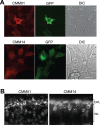TRPM1 Autoantibodies in Melanoma Patients Without Self-Reported Visual Symptoms
- PMID: 31117125
- PMCID: PMC6532695
- DOI: 10.1167/iovs.19-26775
TRPM1 Autoantibodies in Melanoma Patients Without Self-Reported Visual Symptoms
Abstract
Purpose: Melanoma-associated retinopathy (MAR) is a paraneoplastic syndrome associated with cutaneous malignant melanoma (CMM). Visual symptoms include night blindness, photopsia, and reduced-contrast sensitivity. An abnormal ERG b-wave and the presence of anti-bipolar cell autoantibodies, including autoantibodies reacting with the ON-bipolar cell TRPM1 channel, help to confirm the diagnosis. The goal of this study was to determine if CMM patients without visual symptoms also express anti-TRPM1 autoantibodies.
Methods: Serum samples from 15 CMM patients were tested using three assays: immunofluorescent labeling of TRPM1-transfected HEK cells, immunofluorescent labeling of retinal sections from wild-type and TRPM1 knockout mice, and immunoblot detection of a bacterially produced recombinant TRPM1 peptide.
Results: Serum specimens from 5 of the 15 CMM patients without declared visual symptoms were positive for anti-TRPM1 autoantibodies in at least one of the three assays. One of 50 control sera from patients not known to have cancer was also weakly reactive with the TRPM1 peptide.
Conclusions: Autoantibodies against TRPM1 are present in CMM patient sera without self-reported visual symptoms. Most patients had advanced (stage III and IV) disease and were undergoing aggressive treatments, including immunotherapy. It is unknown if immunotherapy affects the expression of TRPM1 autoantibodies. The presence of TRPM1 autoantibodies may predispose patients for MAR.
Figures


References
-
- Milam AH, Saari JC, Jacobson SG, Lubinski WP, Feun LG, Alexander KR. Autoantibodies against retinal bipolar cells in cutaneous melanoma-associated retinopathy. Invest Ophthalmol Vis Sci. 1993;34:91–100. - PubMed
-
- Keltner JL, Thirkill CE, Yip PT. Clinical and immunologic characteristics of melanoma-associated retinopathy syndrome: eleven new cases and a review of 51 previously published cases. J Neuroophthalmol. 2001;21:173–187. - PubMed
Publication types
MeSH terms
Substances
Grants and funding
LinkOut - more resources
Full Text Sources
Medical
Miscellaneous

